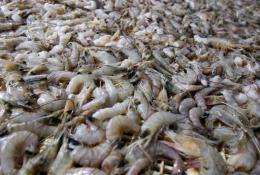Tiny shrimp leave giant carbon footprint: scientist

Measured by environmental impact, a humble shrimp cocktail could be the most costly part of a typical restaurant meal, scientists said Friday.
If the seafood is produced on a typical Asian fish farm, a 100-gram (3.5 ounce) serving "has an ecosystem carbon footprint of an astounding 198 kilograms (436 pounds) of CO2," biologist J. Boone Kauffman said.
A one-pound (454-gram) bag of frozen shrimp produces one ton of carbon dioxide, said Kauffman, who is based at Oregon State University and conducts research in Indonesia.
He told a meeting of the American Association for the Advancement of Science that he developed the comparison to help the public understand the environmental impact of land use decisions.
Kauffman said 50 to 60 percent of shrimp farms are located in tidal zones in Asian countries, mostly on cleared mangrove forests.
"The carbon footprint of the shrimp from this land use is about 10-fold greater than the land use carbon footprint of an equivalent amount of beef produced from a pasture formed from a tropical rainforest," wrote Kauffman in a paper released to AFP, not including emissions from farm development, feeds, supplements, processing, storing and shipping.
The farms are inefficient, producing just one kilogram (2.2 pounds) of shrimp for 13.4 square kilometers (five square miles) of mangrove, while the ponds created are abandoned in just three to nine years because disease, soil acidification and contamination destroy them, he wrote.
After abandonment, the soil takes 35 to 40 years to recover, he said.
Emily Pidgeon of Conservation International said intact mangrove forests are of value in protecting the coastal ecosystems and communities against storms and tsunamis, such as the Indian Ocean tsunami in 2004 that killed some 230,000 people.
The problem, she said, is the value of intact mangroves is hard to measure, and most of the shrimp farms are in impoverished areas that cannot easily afford conservation.
"It's difficult to find the financing to do it, or the political will," she said, adding Kauffman's carbon measurements provide another argument in favor of protection.
The catchy shrimp cocktail estimate is part of the relatively new field in science and economics called ecosystem services, which uses models to measure the value to human communities, in economic terms, of forests, grassland, waterways and even the air.
"To present how deforestation and land cover change contribute to global climate change in a comprehensible manner, we change the scale of greenhouse gas emissions from global to personal scales," wrote Kauffman.
(c) 2012 AFP















